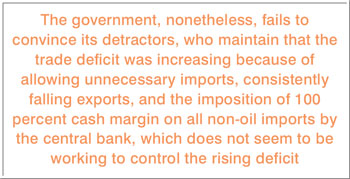INSIGHT
The fragile economy is threatening sustainable and inclusive growth and is becoming a bigger challenge for the next budget due to the yawning over $20 billion trade gap, tumbling foreign exchange reserves, falling home remittances, and declining revenues.
 The current political discourse is likely to get murkier in the wake of the decision on Panama leaks scandal, and tall claims of economic turnaround are losing credibility. This is making the job of the federal planners to work out fresh budgetary proposals for 2017-18 far more complicated.
The current political discourse is likely to get murkier in the wake of the decision on Panama leaks scandal, and tall claims of economic turnaround are losing credibility. This is making the job of the federal planners to work out fresh budgetary proposals for 2017-18 far more complicated.
The projected five percent plus gross domestic product (GDP) growth rate in 2016-17 compared to 4.7 percent of 2015-16 is fast becoming a delusion due to the poor performance of major economic indicators during the first eight months of the current fiscal year.
Marginal growth in agriculture, which remained negative during the last few years, and Large Scale manufacturing (LSM) are also two major factors causing problems. Those who are in the know of things are worried about the remaining four months of the financial year to see certain improvements in major economic indicators.
On top of that, the first Multi-dimensional Poverty Index – that measures non-income based poverty – has classified 38 percent of Pakistan’s population in the multi-dimensional poor bracket. This, according to a State Bank of Pakistan (SBP) report entails multiple policies including revamping weak institutions and national ownership of Vision 2025, a baby of the planning and development minister Ahsan Iqbal.
The federal minister for finance Senator Ishaq Dar does not miss an opportunity to accuse his critics, independent economists and commentators of spreading despondency in the masses through what he calls their “ill- conceived and wrong assessment” of the economy. He alleges that these ‘detractors’ are deliberately showing a disturbing picture of the economy because of their own vested interests. He says those raising questions are working with a certain agenda.
An important question to ponder is how the finance minister will defend the underperforming economy, over which the central bank too is now expressing concerns and calling for taking early actions. The State Bank of Pakistan’s independent and balanced quarterly, half yearly, and annual reports, are being acknowledged by people like renowned economist and former finance minister Dr Hafeez A Pasha.
The growing trade deficit (gap between imports and exports) that has jumped by 34 percent during the first eight months of the current fiscal as against 29 percent in February this year, is threatening the external sector, which is already seeing reduced home remittances and thus posing threats to the reserves position. In addition to that, the current account deficit (gap between export of goods and services) has already reached $4.7 billion in the first eight months of the current fiscal year 2016/17.
The officials of the Ministry of Finance and the central bank maintain that the trade gap was a temporary phenomenon and the situation would ease during the remaining four months by June 30 this year, an argument nobody was prepared to buy, considering the deteriorating external flows, including that of the US Coalition Support Fund (CSF).
The government says that gaps have widened between imports and exports due to machinery related imports for the China-Pakistan Economic Corridor (CPEC) related projects. The government, nonetheless, fails to convince its detractors, who maintain that the trade deficit was increasing because of allowing unnecessary imports, consistently falling exports, and the imposition of 100 percent cash margin on all non-oil imports by the central bank, which does not seem to be working to control the rising deficit.
The issue of escalating trade deficit is alarming as it is now time to witness bulky outflows connected with CPEC and other debt service obligations. The current financial year is going to be extremely difficult to manage, as the government has to make $15 billion repayments in 2016-17 that will hit the reserves position.
These $15 billion include $7 billion for financing debt servicing and $8 billion for managing the current account deficit, which has already reached $4.7 billion during July and January. Safe estimates reveal that the current account deficit will raise the external financing requirement for the current fiscal year to over $13 billion. This situation, according to Dr Hafeez Pasha and Dr Ashfaque Hasan Khan is very frightening, forcing the government to seek additional external borrowing from traditional sources like the World Bank, Asian Development Bank (ADB) and bilateral creditors including new investment from China.
Pakistan has added $12.2 billion of external debt and liabilities in three years of the Pakistan Muslim League-Nawaz (PML-N) government, as against $14.7 billion accrued by the Pakistan Peoples’ Party regime in the previous five years. As such, the speed of foreign borrowing has been somewhat higher in recent years.
Nawaz Sharif government contracted foreign exchange loans of $35 billion since coming into power, out of which $20 billion had been disbursed. Generally there is a consensus among independent economists that external debt is likely to reach over $100 billion by end-June 2020 from the present $74 billion.
Dar maintains the government will have to pay back $2 billion every year to its foreign creditors, while his critics believe the amount is bigger and the government is not telling the truth because elections are around the corner.
Total foreign exchange reserves of the SBP are $22 billion that include $4.8 billion of the commercial banks as well. And out of these $4.8 billion, the government has borrowed $3.3 billion from the commercial banks, called as “forward buying from the market” to be returned to them after three months. Here, the government is doing double accounting, which, in principle, should have been removed from the total reserves. However, this is not happening, which is what is providing an opportunity to the government’s critics, who say the rulers are involved in figure fudging of the foreign exchange reserves.
For commercial banks, it is double jeopardy, as besides the reserves issue, businessmen operating outside the banking system are also costing them dearly due to reduction in the collection of withholding tax on banking transactions. Businessmen and traders are dealing in cash, and such dealings have reportedly doubled in one year. The size of the non-banking or cash transactions have increased from Rs4,800 billion to Rs2,600 billion in one year because of 0.4 percent withholding tax, up 85 percent from 2015.
 Some people are facilitating small traders to keep their money in private lockers on marginal rates. A practice said to be growing with the passage of each day. The issue came to light recently after a small incident in a shop of Raja bazaar, Rawalpindi which caught fire and currency notes worth Rs80 million were destroyed. It was reported to the authorities, but nothing happened as the shopkeepers eventually decided to keep quiet and settled the issue amicably. How many such shops are operating like banks is anybody’s guess, but one thing is certain that small traders are unprepared to pay 0.4 percent withholding tax to banks, which will cost them heavily if they make a number of daily transactions exceeding Rs50,000.
Some people are facilitating small traders to keep their money in private lockers on marginal rates. A practice said to be growing with the passage of each day. The issue came to light recently after a small incident in a shop of Raja bazaar, Rawalpindi which caught fire and currency notes worth Rs80 million were destroyed. It was reported to the authorities, but nothing happened as the shopkeepers eventually decided to keep quiet and settled the issue amicably. How many such shops are operating like banks is anybody’s guess, but one thing is certain that small traders are unprepared to pay 0.4 percent withholding tax to banks, which will cost them heavily if they make a number of daily transactions exceeding Rs50,000.
Multiple issues have been plaguing the economy and if measures are not taken to fix the matters, it is anybody’s guess what will happen after the next election.
The country’s exports have been on a continuous decline for the last many years, which speaks volume about the previous and current governments’ policies. The weak or poor policies have been making the external sector further vulnerable. It is in that backdrop, fears are being expressed that the future government which comes into power as result of 2108 election will have to once again go back to the International Monitory Fund (IMF) for emergency lending. The position of the foreign exchange reserves, which once reached as high as $23 billion plus and contained mainly external borrowing including $8 billion from the IMF, is gradually decreasing and getting indefensible.
The officials of the central bank are reportedly perturbed over the declining home remittances too, as it was the home remittances that previously used to plug the trade gap to some good extent. The situation has become more worrying as the annual target of $20 billion of home remittances looks difficult to achieve due to differences in the inter-bank and open market dollar rate.
Declining exports are not helping the situation either. Unfortunately, even after the government extended Rs180 billion subsidy package to the textile, clothing, sports, surgical, leather, and carpet exporting sectors for boosting their exports, the situation did not improve.
The Pakistani export sector blames it on the overvaluation of rupee. Exporters believe the Pakistani currency is overvalued and needs to be devalued against the dollar to augment exports. Not only that, they also demand the government to release their stuck up refunds. The exporters call out the government for depriving them of their over Rs150 billion sales tax refunds. They say that if the government gives back their refunds, as has been promised time and again, they would be able to reinvest and solve the liquidity crisis which has also been hampering exports. The traders are also very critical of the Commerce Ministry and the minister for commerce Khurram Dastgir Khan, who according to them is not available to resolve their problems in terms of increasing exports. Problems and issues are countless as per the businessmen and traders.
Another factor hindering exports is the inability of the Commerce Ministry to propose reforms in the export sector in the trade related departments, including Pakistani embassies abroad. They accuse the relevant ministries of inefficiencies and lacklustre behaviour which has resulted in plunging the exports down to $20 billion, while imports have almost doubled due to the government’s inaction over the issue.
Lack of value-addition and product diversification is also hampering exports. These factors are rendering Pakistani products uncompetitive against countries like India and Vietnam who are increasing their footprints in the global markets, especially in the textiles sector.
The question being asked was now is how will the government accomplish its task of achieving $35 billion annual export target by 2018 under the three year Strategic Trade Policy uncovered last year?
The speed with which the government is seeking exceptional domestic borrowing to manage its day-to-day affairs is accumulating a large debt, going forward; it has to be avoided to escape adverse macroeconomic consequences. Also Dar must share his thoughts about the economy by inviting the views of experts and economists in the economic advisory committee meeting which has not met for a long time.
The writer is a senior journalist based in Islamabad